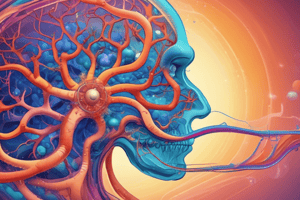Podcast
Questions and Answers
What is the primary function of cellular respiration?
What is the primary function of cellular respiration?
- Production of nutrients
- Intracellular metabolic processes that utilize O2 (correct)
- Exchange of gases with the environment
- Movement of air into and out of the lungs
Which of the following is NOT a step involved in external respiration?
Which of the following is NOT a step involved in external respiration?
- Transport of gases by blood
- Glycolysis (correct)
- Diffusion between tissues and blood
- Ventilation
Which step of external respiration involves the transfer of gases between alveoli and blood?
Which step of external respiration involves the transfer of gases between alveoli and blood?
- Blood transport
- Metabolic processing
- Diffusion of O2 and CO2 (correct)
- Ventilation
What drives the movement of O2 from the atmosphere to the tissues?
What drives the movement of O2 from the atmosphere to the tissues?
In which part of the body does external respiration primarily occur?
In which part of the body does external respiration primarily occur?
What is the role of blood in external respiration?
What is the role of blood in external respiration?
What happens during the ventilation process?
What happens during the ventilation process?
What is the final step of external respiration?
What is the final step of external respiration?
Which metabolic pathway is involved in cellular respiration that takes place in the mitochondria?
Which metabolic pathway is involved in cellular respiration that takes place in the mitochondria?
What is the primary function of the respiratory bronchioles?
What is the primary function of the respiratory bronchioles?
Which condition is associated with an increased production of mucus in the airways?
Which condition is associated with an increased production of mucus in the airways?
What describes the role of cilia in the conducting zone?
What describes the role of cilia in the conducting zone?
What is considered an example of anatomic dead space in the respiratory system?
What is considered an example of anatomic dead space in the respiratory system?
What happens to gas exchange during hyperventilation?
What happens to gas exchange during hyperventilation?
What results from the increased mucus production in chronic obstructive pulmonary disease (COPD)?
What results from the increased mucus production in chronic obstructive pulmonary disease (COPD)?
What percentage of oxygen in the blood is dissolved in plasma?
What percentage of oxygen in the blood is dissolved in plasma?
What is the normal PO2 range in arterial blood?
What is the normal PO2 range in arterial blood?
At sea level, what is the atmospheric pressure when normal air composition is 21% O2?
At sea level, what is the atmospheric pressure when normal air composition is 21% O2?
What is the total oxygen content in arterial blood, assuming normal Hb levels?
What is the total oxygen content in arterial blood, assuming normal Hb levels?
What is the typical hemoglobin saturation in normal arterial blood leaving the lungs?
What is the typical hemoglobin saturation in normal arterial blood leaving the lungs?
What gas exchange process allows for the movement of oxygen from hemoglobin to tissues?
What gas exchange process allows for the movement of oxygen from hemoglobin to tissues?
What percentage of hemoglobin saturation is considered normal?
What percentage of hemoglobin saturation is considered normal?
What factor primarily affects the solubility of oxygen in plasma?
What factor primarily affects the solubility of oxygen in plasma?
What is the relationship between partial pressure of oxygen (PO2) and hemoglobin saturation?
What is the relationship between partial pressure of oxygen (PO2) and hemoglobin saturation?
Which condition would likely cause a decrease in arterial blood gases reflecting lung function?
Which condition would likely cause a decrease in arterial blood gases reflecting lung function?
What is the primary function of the conducting zone within the lungs?
What is the primary function of the conducting zone within the lungs?
Which of the following structures is NOT part of the conducting zone?
Which of the following structures is NOT part of the conducting zone?
How are the lungs structured according to the lobes and segments?
How are the lungs structured according to the lobes and segments?
What type of tissue primarily composes the outer chest wall?
What type of tissue primarily composes the outer chest wall?
What describes the 'anatomic dead space' in the respiratory system?
What describes the 'anatomic dead space' in the respiratory system?
Which statement is true regarding the structural components of the trachea and bronchi?
Which statement is true regarding the structural components of the trachea and bronchi?
What is the role of bronchial smooth muscle in the respiratory system?
What is the role of bronchial smooth muscle in the respiratory system?
What is the approximate volume of air categorized as 'anatomic dead space' during typical breathing?
What is the approximate volume of air categorized as 'anatomic dead space' during typical breathing?
In terms of lung lobes, how are they classified based on their anatomy?
In terms of lung lobes, how are they classified based on their anatomy?
What anatomical feature provides flexible support to the bronchi?
What anatomical feature provides flexible support to the bronchi?
What is the primary function of oxygen in the pulmonary system?
What is the primary function of oxygen in the pulmonary system?
What does the term 'partial pressure' refer to in the context of gases?
What does the term 'partial pressure' refer to in the context of gases?
In terms of blood oxygen levels, what is the significance of oxygen pressure?
In terms of blood oxygen levels, what is the significance of oxygen pressure?
What percentage of oxygen is typically stored in the blood?
What percentage of oxygen is typically stored in the blood?
What mechanism allows oxygen to move through the body?
What mechanism allows oxygen to move through the body?
Which factor is least related to the movement of oxygen in the bloodstream?
Which factor is least related to the movement of oxygen in the bloodstream?
How does the body primarily ensure a readily available supply of oxygen?
How does the body primarily ensure a readily available supply of oxygen?
What role does the pressure gradient play in oxygen delivery?
What role does the pressure gradient play in oxygen delivery?
What occurs when the partial pressure of oxygen is low in the body?
What occurs when the partial pressure of oxygen is low in the body?
Which factor contributes most to the pressure of oxygen in the bloodstream?
Which factor contributes most to the pressure of oxygen in the bloodstream?
Flashcards are hidden until you start studying
Study Notes
Respiration
- The ongoing movement of oxygen from the atmosphere to the tissues and the movement of carbon dioxide from the tissues to the atmosphere.
Cellular Respiration
- The metabolic processes carried out within the mitochondria that use oxygen and produce carbon dioxide, delivering energy.
External Respiration
- The exchange of oxygen and carbon dioxide between the external environment and the cells of the body.
- Four steps:
- Ventilation - Movement of air into and out of the lungs.
- Diffusion - Exchange of oxygen and carbon dioxide between air in alveoli and blood within the pulmonary capillaries.
- Blood Transport - Oxygen and carbon dioxide transported between lungs and tissues.
- Diffusion - Oxygen and carbon dioxide exchange between tissue and blood across systemic capillaries.
Partial Pressures
- Partial pressure influences movement of oxygen.
- Oxygen is readily available in the blood and stored in hemoglobin (Hb), holding 98% of the oxygen.
- Only 5% of oxygen is dissolved in the blood.
- Plasma has lower solubility for oxygen than Hb, making it easier for oxygen to move into Hb.
Pulmonary System
- The pulmonary system helps to transport oxygen.
- Normal atmospheric air composition is 21% oxygen with an atmospheric pressure of 760 mm Hg at sea level.
- Normal arterial blood leaving the lungs has a PO2 of 100 mm Hg and Hb saturation of 98%.
Arterial Blood Gases
- Arterial blood gases reflect lung function.
- Normal PO2 is 80-100 mm Hg and normal Hb saturation is 95-100%.
- Total oxygen content is 20 ml oxygen/100 ml of blood (20 volume percent).
Venous Blood
- Blood that has not gone to any tissue yet reflects the direct function of the lungs.
Lungs - Basic Structure
- Occupy a large portion of the thoracic cavity along with the heart, vessels, esophagus, and thymus.
- Divided into lobes, which are further divided into segments.
- Consist of highly branched airways, alveoli, pulmonary blood vessels, elastic connective tissue.
Outer Chest Wall
- Formed by 12 pairs of ribs and a variety of skeletal muscles.
Conducting Zone
- Stiff and does not engage in gas exchange.
- Includes trachea and bronchi, which contain cartilage for flexibility.
- Bronchioles contain smooth muscle and regulate airway resistance.
- Anatomic dead space - About 150 ml of air is simply moved in and out, which does not engage in gas exchange.
Respiratory Zone
- Includes respiratory bronchioles, alveolar sacs.
- Involved in gas exchange.
- High surface area for capillary exchange.
Dead Space
- Regions of the respiratory system that contain air but do not exchange oxygen and carbon dioxide with blood.
- The conducting zone is anatomic dead space.
Hyperventilation
- Excess air is pushed into the conducting zone and back out, resulting in less gas exchange.
- Shallow breaths reduce gas exchange as more air is pushed into the conducting zone.
Airway Defense
- The conducting zone provides host defense through the mucociliary escalator.
- The mucociliary escalator traps particles and cilia beat upwards to bring the mucus out.
- In healthy individuals, few mucous cells reside within the airway epithelium.
- However, individuals with asthma, cystic fibrosis, or chronic obstructive pulmonary disease (COPD) have increased production and secretion of mucus.
Studying That Suits You
Use AI to generate personalized quizzes and flashcards to suit your learning preferences.




